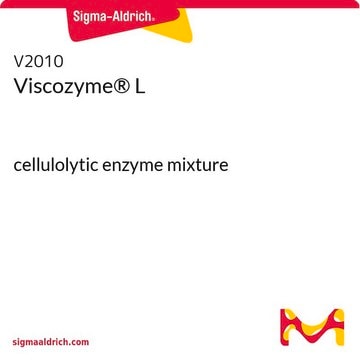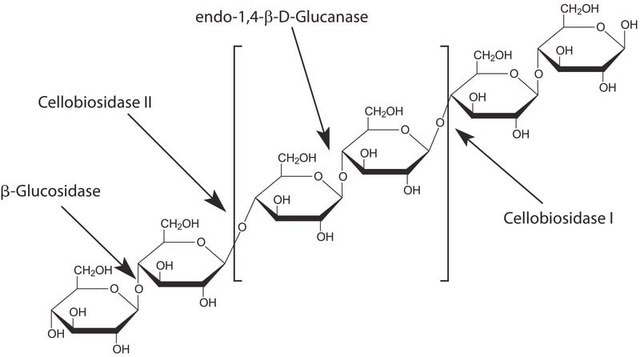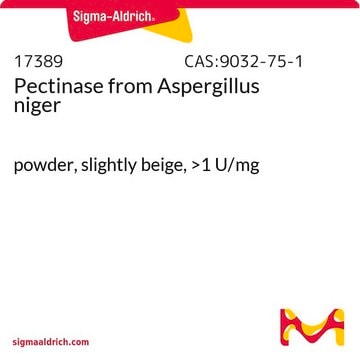おすすめの製品
形状
powder
比活性
≥0.3 units/mg solid
環境により配慮した代替製品の特徴
Design for Energy Efficiency
Learn more about the Principles of Green Chemistry.
sustainability
Greener Alternative Product
環境により配慮した代替製品カテゴリ
, Enabling
保管温度
2-8°C
類似した製品をお探しですか? 訪問 製品比較ガイド
関連するカテゴリー
詳細
FDAはA. niger由来セルラーゼについて、製造に非病原株及び毒素非産生株が使用され、医薬品の製造管理及び品質管理に関する基準(cGMP)が適用されていれば、GRAS(一般に安全とみなされる)であると認識しています。
メルクは、グリーン・ケミストリーの12原則の1つ以上に則った、より環境に配慮した製品(グリーン代替品)をお客様にお届けできるよう最善の努力をします。この製品は、代替エネルギーのための酵素として使用されています。さらなる情報についてはEnzymes for Alternative Energy Researchをご参照ください。
セルラーゼは、種々のセルロース分解微生物から分泌されるグリコシド加水分解酵素のファミリーに属します。
セルラーゼは、種々のセルロース分解微生物から分泌されるグリコシド加水分解酵素のファミリーに属します。
アプリケーション
Sigmaのセルラーゼは、その基質候補のいくつか、セルロース、Avicel PH-101、濾紙について、動物及びトリ消化管における単胃消化時に酵素活性を保護する能力を検討するために使用されています。
この酵素は、二枚貝やエビの加工に役立つ二次的直接食品添加物としても承認されています。
生物化学的/生理学的作用
Aspergillus niger 由来のセルラーゼは、セルロース、リケニン、オオムギのグルカン内に存在するエンド-1,4-β-D-グリコシド結合の加水分解、およびセロオリゴ糖であるセロトリオースからセロヘキソースへの加水分解を触媒します。セロビオースまたはp-ニトロフェニル-β-D-グルコシドは切断しません。この酵素は、キシロシルセリン結合を加水分解することによって、コアペプチドから無傷のグルコサミノグリカンを切断します。
単位の定義
1ユニットは、pH 5.0、37°C、1時間で、セルロースから1.0 μmolのグルコースを遊離させる酵素量です(インキュベーションは2時間)。
その他情報
複合糖質分析のための酵素に関するさらに詳しい情報につきましては、www.sigma-aldrich.com/enzymeexplorerをご覧ください。
シグナルワード
Danger
危険有害性情報
危険有害性の分類
Resp. Sens. 1
保管分類コード
11 - Combustible Solids
WGK
WGK 1
引火点(°F)
Not applicable
引火点(℃)
Not applicable
個人用保護具 (PPE)
dust mask type N95 (US), Eyeshields, Faceshields, Gloves
適用法令
試験研究用途を考慮した関連法令を主に挙げております。化学物質以外については、一部の情報のみ提供しています。 製品を安全かつ合法的に使用することは、使用者の義務です。最新情報により修正される場合があります。WEBの反映には時間を要することがあるため、適宜SDSをご参照ください。
Jan Code
C1184-VAR:
C1184-5KU:
C1184-100KU:
C1184-BULK:
C1184-25KU:
試験成績書(COA)
製品のロット番号・バッチ番号を入力して、試験成績書(COA) を検索できます。ロット番号・バッチ番号は、製品ラベルに「Lot」または「Batch」に続いて記載されています。
この製品を見ている人はこちらもチェック
Meena Ganesan et al.
Biotechnology for biofuels, 13, 124-124 (2020-07-21)
The current production of bioethanol based on lignocellulosic biomass (LCB) highly depends on thermostable enzymes and extremophiles owing to less risk of contamination. Thermophilic bacterial cellulases are preferred over fungi due to their higher growth rate, presence of complex multi-enzymes
Fuxi Shi et al.
ACS omega, 5(38), 24780-24789 (2020-10-06)
A major challenge in converting lignocellulose to biofuel is overcoming the resistance of the biomass structure. Herein, sequential dilute acid-alkali/aqueous ammonia treatment was evaluated to enhance enzymatic hydrolysis of poplar biomass by removing hemicellulose first and then removing lignin with
E Schuster et al.
Applied microbiology and biotechnology, 59(4-5), 426-435 (2002-08-13)
Aspergillus niger is one of the most important microorganisms used in biotechnology. It has been in use already for many decades to produce extracellular (food) enzymes and citric acid. In fact, citric acid and many A. niger enzymes are considered
Structural organization and a standardized nomenclature for plant endo-1, 4-beta-glucanases (cellulases) of glycosyl hydrolase family 9
Urbanowicz BR, et al.
Plant Physiology, 144(4), 1693-1696 (2007)
Paulina Tomaszewska et al.
Annals of botany (2021-12-08)
Diploid and polyploid Urochloa (including Brachiaria, Panicum and Megathyrsus species) C4 tropical forage grasses originating from Africa are important for food security and the environment, often being planted in marginal lands worldwide. We aimed to characterize the nature of their
プロトコル
To standardize an enzymatic assay procedure of cellulase.
ライフサイエンス、有機合成、材料科学、クロマトグラフィー、分析など、あらゆる分野の研究に経験のあるメンバーがおります。.
製品に関するお問い合わせはこちら(テクニカルサービス)








